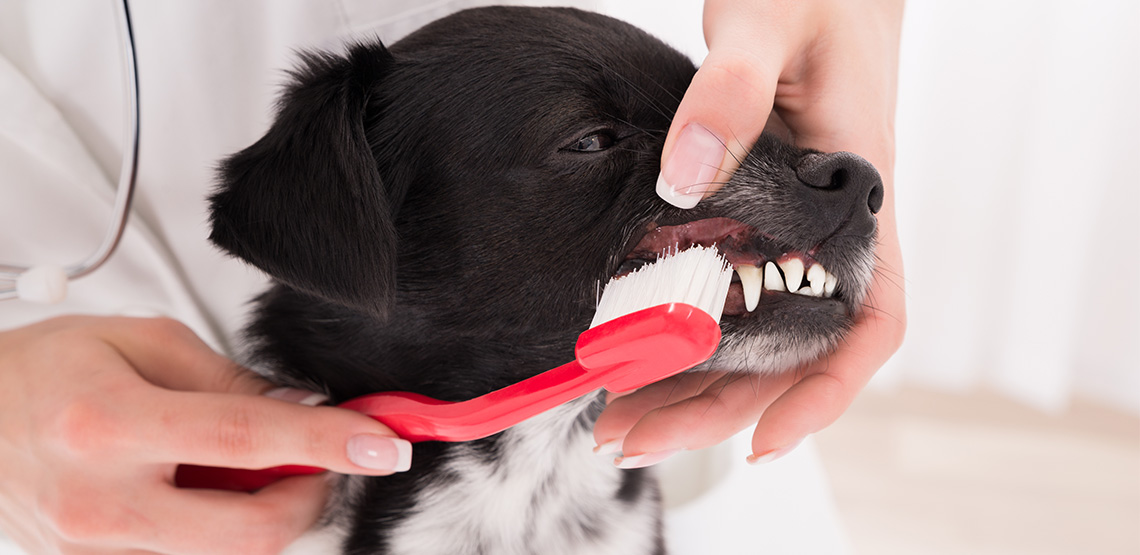Hygiene Practices for Dogs
Dogs have their own natural ways of maintaining certain level of oral hygiene, but sometimes they need a little extra help. Brushing your dog's teeth and giving them healthy oral hygiene chews are helpful when it comes to overall maintenance.
Substances in the saliva act as natural antiseptics, reducing the risk of infection, while the physical action of tearing and chewing food massages and cleans the gums. Under physiological circumstances, the teeth should be well spaced so they do not trap debris. If they are crowded, as in smaller and flat-faced breeds, plaque is more likely to accumulate, thus leading to possible gum infections.
Symptoms of Oral Hygiene Issues in Dogs
Unfortunately, in some cases the natural ways of maintaining oral hygiene are not enough. In those cases oral and dental issues occur, some of which can have serious consequences. For example, gum infections are not only painful and debilitating, but can also be a source of bacteria that will travel to other parts of the body via the bloodstream.
Mouth and tooth problems are one of the most common conditions that require veterinary attention. Signs that your dog has dental problems include:
- Halitosis (bad breath).
- Changed teeth (broken, loose, discolored, misaligned or missing).
- Slow eating.
- Eating with tilted head.
- Decreased appetite.
- Gagging.
- Yellowish-brown tartar buildup.
- Pawing at its mouth.
- Excessive drooling.
- Difficulty swallowing.
- Teeth chattering.
- Bleeding, swollen or red gums.
- Unusual growths inside the mouth.
When the natural ways of maintaining good oral hygiene fail, it is time to take the matter (or in this case the toothbrush) into your own hands and help your furry baby keep its mouth clean.
The modern market does not offer products or methods that will improve your dog’s oral health better than regular brushing with appropriate toothbrush can. Simply put, there is no alternative to brushing. In the past it was believed that plain brushing is enough for maintaining the dog’s oral hygiene on a satisfactory level.
Today, many scientific data shows that the effects of brushing can be boosted and maximized by using suitable toothpaste. The term “suitable” is not used lightly. It is imperative to never use human toothpaste on your dog.
Toothpaste for Dogs
Human toothpastes contain non-edible ingredients that dogs cannot metabolize properly if swallowed. These substance can be not only harmful, but if ingested in larger quantities, even toxic. Therefore if you plan on brushing, you need to purchase toothpaste specifically formulated for dogs.
Aside from being safe, the dog toothpaste needs to be tasty. Popular toothpastes for dogs include flavors like chicken, beef, vanilla and peanut.
You May Also Like:
Related Search Topics (Ads):
Toothbrushes for Dogs
It should also be noted that human toothbrushes are not best suited for dogs because their heads are not angled and their bristles are too sharp or firm and not deep-rooted. From an anatomical perspective, using non-angled toothbrushes is ineffective since the brush’s head cannot reach every spot in your dog’s mouth.
Additionally, if the bristles are sharp and firm they can damage the dog’s sensitive gums. Furthermore, if the bristles are not firmly rooted they can dislodge, stick between two teeth and cause inflammation.
The ideal toothbrush for dogs should feature an angled head with soft, but firmly rooted bristles. There are several types of dog toothbrushes: the single head brush, the multiple-head brush and the finger brush. Each type has its pros and cons. The ultimate choice depends on what you find easiest to use.
Training Your Dog to Let You Brush its Teeth
Last but not least, we need to say a word or two about the hardest part of maintaining your dog’s oral hygiene: training your dog to let you brush its teeth. The best way to train your dog is to start while young. You can start by putting your fingers inside its mouth so it can get used to the idea of having something other than food there.
Then start using a small toothbrush. Begin by brushing for few seconds at a time. At first you do not even need to brush; it is enough to just put the brush in your dog’s mouth and rotate it around the oral cavity. As the dog gets used to this, you can gradually increase the brushing time.
It is advised to always give food rewards after completing the brushing ritual. That way your dog can easily link the brushing with a positive experience.
Luckily, dental health problems can be easily prevented. All you need is a canine toothbrush, a canine toothpaste and a little strategy. In a nutshell, if you want your dog’s mouth to be clean and healthy, you need to:
- Schedule regular oral examinations at the vet.
- Have your dog’s teeth professionally cleaned at least once a year.
- Brush your dog’s teeth regularly (preferably every day). Recent studies suggest that brushing less than three times a week has the same effect as no brushing at all. Therefore it is recommended to brush the teeth at least every other day.

